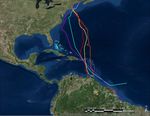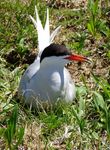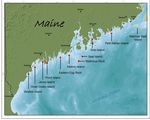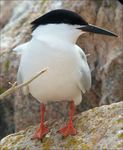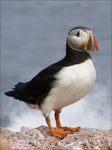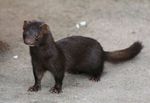Seabird Restoration & Research Efforts: 2018 - US Fish and ...
←
→
Page content transcription
If your browser does not render page correctly, please read the page content below
U.S. Fish and Wildlife Service
Seabird Restoration & Research Efforts: 2018
Maine Coastal Islands National Wildlife Refuge
The 2018 seabird nesting season was a mix of conservation success stories as well as a continued example of how many
species of wildlife are struggling to adapt to changes in the Gulf of Maine. Maine Coastal Islands National Wildlife Ref-
uge actively manages six seabird colonies along the Maine coast. We place seasonal technicians on the islands for 10-14
weeks to monitor the seabirds, control predators, and conduct research. One of the highpoints of this season was the first
successful nesting of common murres in Maine in over 130 years! Technicians working on Matinicus Rock documented
at least six murre chicks. We hope this is the first step in establishing a thriving
murre colony on Matinicus Rock. In addition, Seal Island NWR continues to sup-
port the largest tern and puffin colonies in Maine. The Refuge also continues to be
involved in several research projects, as we try to better understand seabird ecology
and the challenges that seabirds are facing. Our 2017 pilot effort to track common
terns with solar powered satellite tags continues to shed new and exciting infor-
mation on tern foraging, migratory, and wintering behavior. We are now using
DNA analysis of seabird feces to help identify what species of fish the birds are
consuming. We hope this information will assist us in our efforts to work with fish-
eries management agencies to manage the commercial harvest of forage fish.
Common tern chick
We also had some conservation challenges this season. The entire Ship Island com-
mon tern colony of 519 pairs abandoned the island just their eggs were beginning to hatch. We believe a great horned
owl was raiding the colony, and the adult terns chose to abandon the island to avoid the threat of predation. We also had
a snowy owl predating seabirds at Petit Manan Island in late June, long after that bird should have flown north.
Much of our seabird restoration and research success is only possible due to our great partnership with National Audu-
bon Society, who help us manage Matinicus Rock, Pond, and Seal Islands. We also have established great partnerships
with several universities (i.e. University of New England, Long Island University, UMASS, and Boston University), in
an effort to better understand seabird foraging ecology and diet.
Increasing Ocean Temperatures Linked to Decline in Forage Fish Availability:
Sea surface temperatures (SST) in the Gulf of Maine were noticeably warmer during the spring of 2018. That
warming trend continued throughout the summer. By early August, SST were approaching 700, which is 50
above the 30 year average. Researchers have determined that the Gulf of Maine is warming faster than 99% of
the global ocean. We believe that forage fish either sought deeper, cooler waters or moved further north. Either
way, seabirds were not able to find suitable fish to feed their chicks. Seabird colony technicians working
throughout the Gulf of Maine documented a decline in food deliveries to tern and
puffin chicks in mid-July. Productivity rates at many of the tern colonies were 30-
40% below average. Puffin chicks take longer to develop and generally don’t
leave the islands until early August. As a result, the decline in forage fish availa-
bility was particularly challenging for puffins. On several islands, we documented
that the puffin chicks stopped developing for several weeks. While many puffin
chicks died, other chicks started growing again in mid-August when water tem-
peratures started to decrease. Seabird managers have not observed this phe-
nomena occurring in our 35 years of monitoring puffins. It is unclear what effect
this food shortage might have on the long-term survival rates of chicks that were
eventually able to fledge from their burrows. Puffin ChickPage 2 Maine Coastal Islands NWR
Current Estimate of Seabirds Breeding in Maine
Species # Breeding Pairs # Colonies
Roseate Terns 245 5
Arctic Terns 2,523 8
Common Terns 9,515 12-14
Atlantic Puffin 1,145+ 5
Laughing Gull 775 3
Great Cormorant 38 2
Razorbill 750+ 6
Double Crested Cormorant 9,510 81
Herring Gull 21,488 180
Great Black-Backed Gull 6,934 183
Common Eider 21,000 320
Black Guillemot 12,000 adults 166
Leach’s Storm Petrel 10,370 33
Species in shaded boxes are not surveyed every year, and the data represents the most recent survey information.
Pairs of Roseate Terns Nesting in Maine: 1987-2018
350
300
250
Pairs
200
150
100
50
0
87
93
99
5
1
7
'0
'1
'1
Roseate Tern Year
The entire northeast population of roseate terns experienced a significant declined between 2000 and 2009. Managers do not know
the cause of that decline. Conditions seem to have improved and the population has increased by 45% since 2013. Researchers are
trying to learn about where the terns spend the winter (Brazil and Argentina) and any potential threats they may face during migration.Page 3 Maine Coastal Islands NWR
Common and Arctic Tern Recovery in Maine: 1987-2018
12000
10000
8000
Pairs
6000
4000
2000
0
87 89 91 93 95 97 99 1 3 5 7 9 1 3 5 7
'0 '0 '0 '0 '0 '1 '1 '1 '1
Year
Common Arctic
In Maine the common tern population has increased by 28% since 2008, while the Arctic tern population has decreased by 41% dur-
ing that same time period. The cause of the Arctic tern decline is unknown, but it appears that colonies across the globe are declin-
ing. This suggests that issues outside the breeding range may be influencing the species. Arctic terns winter along the icepack of the
Antarctic, and complete annual migrations that exceed 42,000 miles !
Pairs of Laughing Gulls Nesting on Petit Manan, Matinicus Rock,
and Eastern Egg Rock: 1984-2018
Control Efforts Implemented
5000
Pairs of Laughing Gulls
4500
4000
3500
3000
2500 Egg Rock
2000
1500 Matinicus Rk
1000
500
Petit Manan
0
84
87
90
93
96
99
02
05
08
11
14
17
19
19
19
19
19
19
20
20
20
20
20
20
Year
In Maine, laughing gulls only nest on 3-4 islands where seabird managers prohibit the larger great black-backed and herring gulls from
nesting. Laughing gulls prey on tern eggs and chicks, and complete with the terns for nesting habitat. Laughing gulls will also steal
food from the terns, particularly in years when preferred food (herring and hake) appear to be scarce. To enhance tern productivity
and decrease competition for nesting habitat, USFWS and NAS began a Laughing Gull control effort in 2008Page 4 Maine Coastal Islands NWR
Location of Managed Seabird Colonies in Maine
Results of 2018 Seabird Surveys in Maine
Island Common Arctic Tern Roseate Atlantic Razorbill Laughing
Tern Tern Puffin Gull
Petit Manan 899 378 0 62 3 766
Ship Island 519 0 0 0 0 0
Seal 1,207 831 0 565 59 0
Matinicus Rock 268 717 0 355+ 400+ 8
Metinic 351 491 0 0 0 0
Eastern Egg Rock 1,021 86 87 178 0 1
Pond 1,065 11 2 0 0 0
Jenny 1,426 1 24 0 0 0
Outer Green 1,553 0 4 0 0 0
Stratton 1,206 8 128 0 0 0
All other islands 25 5 0 2-4 No census 0
2018 TOTAL 9,540 2,523 245 1,145+ Est 750 775
2017 TOTAL 8,540 2,151 245 1,100 Est 750 2,365Page 5 Maine Coastal Islands NWR
Research Needs at MCINWR:
Foraging ecology and diet information for terns, puffins, and razorbills
Strategy: New tern GPS tracking project planned for 2019
Influence of climate change and commercial harvest on forage fish availability
Strategy: Continue research in seabird diet using fecal DNA
Reason for recent decline in Arctic terns and great cormorants
How other species of concern such as shorebirds, songbirds, raptors and bats are
utilizing the Maine coast during migration
Migration and wintering distribution of puffins and razorbills
Foraging ecology of Leach’s storm-petrels, and better methods for monitoring petrel
populations
Strategy: New graduate student research project on petrels planned for 2019
Potential wildlife conflicts with offshore wind development
Research Highlight: Using DNA Analysis to understand Seabird Diet
In 2017, MCINWR began to partner with the University of New England to use the DNA in seabird feces
to understand what species of fish the seabirds are consuming. Although our seasonal technicians
spend many hours each summer documenting what diet items are fed to seabird chicks, we know very
little about the diet of adult seabirds. It looks like DNA analysis will help us answer that question! The
common tern data below indicates that the DNA in common tern feces indicates the birds are eating
several species of fish that we haven’t recorded during our feeding studies. We con-
tinued collecting samples from terns and puffins in 2018 and are anxious to see the
results for the seabirds nesting on PMI, Metinic, Seal, and Matinicus Rock.
DNA Analysis Observations of Chick FeedingsPage 6 Maine Coastal Islands NWR
Research Highlight: Tracking Common Tern Foraging, Migration, and Wintering
Behavior Using Satellite Tags
In 2017, the Refuge attached solar powered satellite tags to five common
terns at Petit Manan Island. The tag weighed only two grams and were at-
tached with harnesses. This is a new attachment method for us, and we
needed to monitor the terns to make sure there were no adverse effects
from the tagging effort. We used GoPro cameras to monitor the terns and
their chicks throughout the breeding season. The tags could potentially
transmit data for several years.
This technology allowed us to track their daily foraging efforts as the terns
flew up to 50 km to find food for their chicks.
Upon completion of the breeding season was over, all five terns flew
to Cape Cod where they spent 1-4 weeks feeding on sand lance and Tagged common tern ready for re-
herring before continuing their migration to South America. lease on Petit Manan Island
Fall Migration
Routes
Cape Cod: Fall Staging area for all 5 common terns
Map to the Right: Female common terns (yellow lines)
departed Cape Cod in mid August and flew to Vene-
zuela in six days. Male common terns (red lines)
stayed on Cape Cod until mid September and took 7-
10 days to reach Venezuela. All three male terns en-
countered at least one hurricane during their migra-
tion. The birds travelled an average of 4,432 km on
their fall migration.Maine Coastal Islands NWR Maine Coastal Islands NWR
Wintering Areas:
Three of the satellite tags continued trans-
mitting the terns’ movements during the
winter of 2017-18. The birds spent time in
Suriname and French Guiana, before Marajo Bay
spending the majority of the winter in Bra-
zil. In particular, all three birds spent con-
siderable time in Marajo Bay east of the
Amazon River estuary. One tern continued
flying along the Brazilian coastline and
reached Argentina before the transmitter
failed.
Wintering locations of three common terns. Red areas repre-
sent those locations used most frequently, while blue areas
show migration corridors used by the terns.
Spring & Fall The satellite tags on the two females
Migration Routes (743 and 744) allowed us to document
their northward migration in May
Female 743:
(purple and green lines). The birds trav-
Fall 17 ------ elled over 6,200 km before they
Spring 18 ------ reached Petit Manan Island to begin the
Fall 18 ------ 2018 nesting season. By August, only
Female 744: one tag remained active but we were
Fall 17 ------ able to document a second fall migra-
744 Spring 18 ------ tion for female 743 (orange line) and
continue to track her movements
throughout the winter of 2018-19.
This is the first time common terns have
been tracked with satellite tags. We
hope to use this information to better
understand their foraging ecology, to
document the location of foraging areas
in the Gulf of Maine, to document mi-
gration corridors, and to identify winter-
ing areas in South America.Page 8 Maine Coastal Islands NWR
Need for Restoration:
Arctic, common, and roseate tern populations were decimated in the Gulf of Maine in the late 1800's due
to a combination of shooting and egging for use as food and bait. Thousands of terns were also harvest-
ed to provide feathers for the growing millinery trade. When these activities were halted in the early
1900's, tern populations increased to at least 14,775 pairs in 1931 (including Machias Seal Island). Un-
fortunately for the terns, gulls also benefited from federal protection, and their numbers rapidly increased
along the coast. The prevalence of open landfills allowed herring and great black-backed gulls to produce
a greater number of chicks. These chicks also experienced higher survival rates due to the year-round
abundance of food. Both species are effective predators of tern eggs and young, and their presence can
lead to complete nesting failure or island abandonment by many species of seabirds. Gulls also initiate
nesting earlier in the season than terns, which forces terns to nest in marginal habitat. As a result, terns
may be more vulnerable to increased predation, inclement weather, and flooding from storms. We esti-
mate that in the early 1900’s the Gulf of Maine supported 10,000 pairs of gulls. By the late 1970's, that
number had increased to 100,000 pairs. The combination of expanding gull populations and habitat loss
resulted in a 50 year decline in the tern population. We estimate by 1977 the Gulf of Maine tern popula-
tion had decreased to 5,320 pairs. Since 1977, a management plan developed and implemented by the
Gulf of Maine Seabird Working Group (GOMSWG) has worked to reverse this decline.
How do we restore a seabird colony?
The first task in re-establishing a colony is to make it safe for terns to nest on their former breeding is-
lands. In some cases, it was sufficient to maintain a human presence on the island to discourage nesting
gulls. In other cases, small populations of gulls have been controlled through egg and nest destruction,
pyrotechnics, and limited shooting. Larger gull populations were removed with avicide DRC 1339. Avicide
allowed managers to remove the breeding population of gulls in a relatively short period of time. Contin-
ued gull harassment and nest destruction prevents any additional gulls from settling on the island. If the
terns had recently abandoned the site, they may quickly return to the island once the gulls are removed.
In situations where terns had not utilized the island in decades, it was necessary to actively attract birds
to the islands using social attraction equipment. Managers use sound systems to continuously play the
sounds of a tern colony and tern decoys were scattered across the island. Social attraction has been
shown to be highly effective in re-establishing seabird colonies on several islands within the Gulf of
Maine. Laughing gull, common eider, Leach’s storm-petrel, Atlantic puffin, razorbill, and black guillemot
may also colonize the islands once the gulls are removed.
Common Tern Decoy Razorbill Decoys Atlantic Puffin visiting a Razorbill DecoyPage 9 Maine Coastal Islands NWR
Petit Manan Island (PMI)
Petit Manan is a 16 acre island located approximately three miles south of Petit Manan Point in
Steuben. This island was historically one of the most important colo-
nial nesting seabird islands in the Gulf of Maine. Significant num-
bers of terns had nested on PMI, including 1,500 pairs observed in Atlantic Puffin
1971. The light station was automated in 1972, meaning US Coast
Guard (USCG) staff no longer needed to live on the island. The num-
bers of nesting gulls gradually increased on PMI after the USCG de-
parted. The Service acquired this historic lighthouse station in 1974.
By 1983 terns no longer nested on PMI, but they were attempting to
nest on various other islands in the region. The Service initiated gull
control on PMI in 1984, and within one week the terns returned to
the island. We believe the rapid success of this project was due to the
return of Arctic and common terns that had temporarily been dis-
placed from Petit Manan due to the presence of nesting gulls.
In 2018 the island supported 899 pairs of common terns, 378 pairs
of Arctic terns, and 766 pairs of laughing gulls. No endangered rose-
ate terns nested on the island this season. The terns primarily fed
their chicks herring and hake this season, but food deliveries for all
species decreased sharply in late July. Common tern productivity was 0.88 chicks /pair while Arctic
terns produced 0.69 chicks /pair. The Refuge is currently studying the effects of prescribed fire and
mowing on the islands’ vegetation.
In 2009, the island supported a record high of 104 pairs of puffins.
Unfortunately the puffin colony has declined in recent years, and the
island supported 62 pairs of puffins this season. We believe puffins
burrows have been destroyed by storms and we have been con-
structing artificial burrows for the puffins. This season we had a high
count of 178 puffins, 34 razorbills, 10 common murres, and 240
black guillemots visiting PMI. We documented three pairs of razor-
bills nesting this year, but all three attempts failed. Leach’s storm-
petrels, black guillemots, and common eiders also nest on PMI.
Arctic Tern
Seabirds Nesting on Petit Manan: 2014-2018
Year Common Arctic Tern Roseate Atlantic Laughing
Tern Tern Puffin Gull
2014 668 524 0 73 560
2015 709 477 0 77 620
2016 574 384 0 55 543
2017 657 431 0 58 605
2018 899 378 0 62 766Maine Coastal Islands NWR
Page 10
Ship Island
Ship is an 11 acre island within Blue Hill Bay, located 2.5 miles from Tremont. Historically Ship Island
supported over 300 common tern nests, while an additional 500 pairs nested on the adjacent Trumpet
Island. Terns stopped nesting on Ship and Trumpet in the 1940’s. A tern restoration project was initiat-
ed in 1993, and in 1995, after an absence of more than 50 years, terns once again nested on Ship Is-
land. The colony continued to grow and by 1999, the island sup-
ported 558 pairs of common terns. Between 2000 and 2004 mink
and possibly other predators disrupted the colony, resulting in high
abandonment rates and very few chicks being produced. The Ref-
uge decided to terminate the Ship Island project in 2005, however
terns continued to nest on the island in small numbers.
After reviewing survey data for the coast of Maine, the Refuge de-
cided to return to Ship Island in 2010. We believed that we had
gained sufficient skills to address the mink predation issues. In ad-
dition, terns continued to nest throughout the Blue Hill Bay system
and we believed that the birds deserved a chance to nest on an
island where predators are controlled. The terns responded to our
management actions and have nested on the island for the past
nine years, and productivity rates are generally very good on the Common Tern
island. In 2018 the island supported 519 pairs of terns. While
mink have not been a problem in recent years, we have struggled
to control great horned owls. We have removed four owls from the
island, and believe a great horned owl caused the complete abandonment of the island in mid June. No
tern chicks were raised on the island in 2018. The Refuge will increase our live trapping efforts in 2019
to try and remove the owl before it can adversely impact the tern colony.
In recent years, the Refuge has been trying to create additional nest-
ing habitat in areas of the island that are safe from flooding during
storm tides. We have created several gravel / sand nesting areas in
the upland portion of the island. We have also conducted prescribed
burns on Ship Island in recent years to enhance nesting habitat for
the terns. Invasive plants remain a management concern across the
entire island as they limit potential nesting habitat for the terns.
American Mink (Photo: Wikipedia) Great Horned Owl
Photo: Park Service CanadaPage 11
Maine Coastal Islands NWR
Seal Island NWR
Seal Island NWR is a 65 acre rocky island located just six miles east of Matinicus Rock, in outer Pe-
nobscot Bay. Seal Island was once the largest Atlantic puffin colony in the Gulf of Maine. For over 200
years it was also a summer campsite for fishermen harvesting herring, groundfish, and lobster. The fish-
ermen also used their nets to harvest the nesting seabirds, which led to the demise of the colony by
1887. The island was eventually re-colonized by cormorants, gulls, and terns. By 1953 the growing gull
population had completely displaced all nesting terns. The US Navy used the island as a bombing target
from the 1940’s – 1960’s. The Service acquired the island in 1972, and began a seabird restoration ef-
fort in 1984. After six years of gull control and social attraction, 20 pairs of Arctic and common terns
nested on Seal Island in 1989. In an effort to jump-start a breeding population of puffins on the island,
National Audubon Society translocated 950 puffin chicks from Newfoundland to Seal Island between
1984-89. The effort was successful and puffins successfully bred on Seal Island in 1992. In 2018, the
island supported 831 pairs of Arctic terns and 1,207 pairs of common terns. Food resources were scarce
this year and common tern productivity dropped to 0.48 chicks / pair while Arctic terns produced 0.76
chicks / pair. The primary diet items delivered to tern chicks were hake and butterfish. Seal Island sup-
ported 565 pairs of puffins and 59 pairs of razorbills his season. Atlantic puffins produced 0.60 chicks /
pair. Seal Island continues to be one of the few islands in the US to support breeding great cormorants,
and this season 32 nested on the island. During the nesting season Explorer.org broadcasts images of
the seabird colony, including a camera inside an active puffin burrow. Seal Island continues to be cooper-
atively managed by National Audubon Society and the Service.
Seabirds Nesting on Seal Island: 2014-2018
Year Common Tern Arctic Tern Razorbill Atlantic
Puffin
2014 1,383 855 19 492
2015 1,380 861 32 397
2016 1,309 949 26 510
2017 1,079 739 36 509
2018 1,207 831 59 565
Matinicus Rock & Seal Island….Not Just for the Birds
In January 2016, the National Marine
Fisheries Service flew an aerial sur-
vey of the Maine coast to count gray
seal pups. Gray seals give birth in
December and January. The survey
found pups on four islands in Maine,
including two Refuge Islands: Seal
and Matinicus Rock. Seal island had
over 1,040 pups while Matinicus
Rock had over 140 pups.Page 12 Maine Coastal Islands NWR
Matinicus Rock
Matinicus Rock is a 27 acre island located 24 miles south of
Owls Head. The island was owned by the USCG for over 155
years, and is the site of the historic Matinicus Rock Light Sta-
tion. In the early 1900’s, National Audubon Society placed
wardens on the island to protect the nesting seabirds. As a
result, Matinicus Rock was the only puffin colony (2 pairs)
within Maine to survive the hunting that decimated most
seabird colonies. Since 1900, Matinicus Rock has been a
principal breeding site for Arctic terns on the Maine coast. In
1901, there were approximately 500 pairs of terns, and the
population increased to approximately 3,000 pairs by 1931.
In 1990, 1,252 pairs of Arctic terns nested on Matinicus
Rock. This decline was likely the result of terns moving to
the newly established colony on Seal Island NWR. The USCG
transferred the island to the U.S. Fish and Wildlife Service in
1999. In 2018, Matinicus Rock supported 268 pairs of com-
mon terns and 717 pairs of Arctic terns. Terns primarily fed
their chicks hake and amphipods this season. Productivity
rates were low for both species, with common terns producing 0.54 chicks / pair and Arctic terns
producing 0.55 chicks / pair. In 2014, the island supported 689 pairs of laughing gulls but since
2015 the island staff have harassed the gulls during the settlement period. The approach has
been extremely effective, and this year only eight pairs of gulls nested. We estimate a minimum of
355 puffins and 400 razorbills nest on the island. Productivity was low for both species with puf-
fins producing 0.45 chicks / pair and razorbills producing 0.62 chicks / pair. We confirmed eight
active murre nests this season, and six chicks were produced. This represents the first successful
breeding effort by common murres in Maine in over 130 years! Matinicus Rock also supports the
only known active breeding location of manx shearwater in the United States. This was the 10th
year that shearwaters bred on the Island, and the research crew observed seven adults and con-
firmed five chicks. Matinicus Rock continues to be cooperatively managed by National Audubon
Society and the Service.
Seabirds Nesting on Matinicus Rock: 2014-2018
Year Common Tern Arctic Tern Razorbill Atlantic Puffin Laughing Gull
2014 223 564 No count 689
2015 206 709 No count 0
2016 167 621 400+ 355+ 35
2017 166 600 No count 1
2018 268 717 No count 8Page 13 Maine Coastal Islands NWR
Metinic Island
The Service acquired 149 acres of the 330 acre Metinic Island in 1994 and 1995. The island is located
12 miles southeast of Rockland. Sheep have grazed the island for generations, and we use them to help
manage the vegetation on the island. The Service excludes the 120 sheep from the tern nesting area
each summer. When the Service acquired Metinic, a small number of terns nested on the island, how-
ever the presence of nesting gulls limited the productivity of the colony. In 1998, the Service initiated a
tern restoration project on the north end of the island. The Service placed tern decoys and a sound sys-
tem, which played the sounds of an active tern colony in an effort to attract additional terns. Although
terns landed among the decoys, no terns nested within the restoration area. In 1999, one pair of com-
mon terns and two pairs of Arctic terns nested adjacent to the decoy area. Later in the season, nine ad-
ditional pairs of terns nested near the decoys. By 2004, the colony had grown to over 700 pairs of
terns. In 2012, a combination of a severe storm, gull predation, and gull control efforts (i.e. extensive
shooting) combined to cause the abandonment of the Metinic tern colony. The colony returned in 2013,
and by 2018 the island supported 351 pairs of common terns and 491 pairs of Arctic terns. The island
also supports nesting black guillemots, common eiders, Leach’s storm-petrels, herring, and black-
backed gulls. The island is managed by the Service.
Tern Nesting on Metinic Island: 2014-2018
Year Common Tern Arctic Tern
2014 220 257
2015 343 260
2016 290 317
2017 331 295
2018 351 491
Pond Island NWR
The U.S. Fish and Wildlife Service acquired Pond Island from the USCG in 1973. The 10 acre island is
located in the mouth of the Kennebec River, and until 1937 supported a common tern colony. Roseate
and common terns nested on the nearby North and South Sugarloaf Islands until 1987. Historically,
North Sugarloaf was the largest roseate colony in Maine. Nesting gulls had displaced terns on all three
islands prior to the restoration efforts that began in 1996. One pair of common terns nested in 1996,
and five pairs nested in 1997. Unfortunately, none of these nesting attempts produced any chicks. In
1998, when the one pair of terns nesting on Pond failed to hatch their eggs, NAS transplanted two com-
mon tern chicks from the nearby Jenny Island. The chicks were immediately cared for by the adults,
and later fledged from the island. In 1999, 10 pairs of common terns nested and for the first time in
more than 60 years, raised chicks on Pond Island. The colony has continued to grow, and in 2018 Pond
Island supported a record high of 1,065 pairs of common terns, 11 pairs of Arctic terns, and two pairs
of endangered roseate terns. Common terns produced an average of 1.28 chicks / pair and primarily
fed their chicks sand lance and herring. This island continues to have chronic predation issues, and this
year the crew live-trapped a snowy owl and also observed evidence of a mink on the island. In recent
years, the technicians have been very successful at quickly trapping the owls, and tern productivity re-
mains high on the island. Pond Island is cooperatively managed by National Audubon Society and the
Service.Maine Coastal Islands NWR
Page 14
Tern Nesting on Pond Island: 2014-2018
Year Common Tern Arctic Tern Roseate Tern
2014 612 4 0
2015 685 6 0
2016 773 6 1
2017 942 8 3 late season nests
2018 1,065 11 2
Machias Seal Island (MSI)
Machias Seal Island lies along the Maine and New Brunswick border
and is the largest puffin and razorbill colony in the Gulf of Maine. In
2004, they documented 2,158 Arctic and 1,006 common tern nests,
at least 3,500 pairs of Atlantic puffin, 560 pairs of razorbills, and 136
pairs of common eider. Unfortunately a combination of adverse weath-
er events and a lack of herring to feed the chicks resulted in total nest-
ing failure in 2005. No terns nested on the island in 2007 or 2008. In
late 2009, thousands of terns arrived on the island and demonstrated
courtship behavior. In 2011, the researchers estimated that 600 pairs
of terns tried to nest on MSI. Unfortunately a combination of peregrine
falcon and gull predation resulted in complete abandonment of the
tern colony in late June. In 2014, 179 pairs of Arctic terns and eight
pairs of common terns nested on MSI, but only produced four chicks.
In 2018, 450 pairs of Arctic terns and 26 pairs of common terns nest-
ed on MSI. Due to the complexity of the alcid nesting area it is very
difficult to get accurate counts of breeding pairs. The most recent esti-
mates are: at least 2,850 pairs of razorbills, 5,400 pairs of Atlantic
puffins, and 350-500 pairs common murres . The Atlantic Cooperative
Wildlife Ecology Research Network has been conducting seabird re-
search on MSI since 1995. Several commercial tourboat operators visit the island and bring a limited
number of tourists ashore. The ownership of the island is disputed between the United States and Cana-
da. The Canadian Coast Guard staffs the lighthouse on the island. The Service has a Memorandum of
Understanding with Maine Department of Inland Fisheries and Wildlife (MDIFW) to manage the island.Maine Coastal Islands NWR Page 15 Eastern Egg Rock Eastern Egg Rock (EER) in Muscongus Bay was the first island in Maine to have an active tern restoration program. Common and Arctic terns had been displaced by gulls by 1937, but restoration activities lead to re-colonization of the island in 1980. The tern colony increased to 597 pairs in 1983, but declined to just 54 pairs between 1984- 1986 due to a combination of avian cholera, restoration of the Petit Manan tern colony, and black-crowned night heron predation. The colony has steadily increased since 1986, and this year the island supported 1,021 pairs of common terns, 86 pairs of Arctic terns, 87 pairs of roseate terns, and 178 pairs of puffins. EER supports 35% of the Maine roseate tern population. In recent years, EER has also supported over 2,000 pairs of laughing gulls but this year the colony moved to Western Egg Rock. The island is owned by the Maine Bureau of Public Lands, and is cooperatively managed by National Audubon Society and MDIFW. Jenny Island The two acre Jenny Island is located within Casco Bay, an area that once supported nesting terns on at least nine different islands. By 1990, the expansion of gulls in the Bay reduced the population to 124 pairs of common terns, nesting on three islands. Gull control and increased human presence on Jenny Island were implemented in 1991. The tern colony at Jenny Island increased from 45 pairs in 1990 to 1,050 pairs in 2000. In 2018, 1,426 pairs of common terns, one pair of Arctic terns, and 24 pairs of roseate terns nested on the island. The island is owned by the Maine Bureau of Public Lands, and is cooperatively managed by National Audubon Society and MDIFW. Stratton Island Stratton Island is a 35 acre island located in Saco Bay, approximately 1.5 miles off Prouts Neck, in Cape Elizabeth. The island supported 1,500 terns in 1937, unfortunately gulls continued to displace the terns until the entire tern colony was extirpated in 1986. The tern restoration project was initiated in 1987, and succeeded in restoring five pairs of common terns. The colony continued to grow, until chronic predation by black-crowned night heron com- pletely eliminated all productivity and reduced nesting numbers for numerous years. Managers applied aversive taste repellents on the tern chick’s leg bands, but that did not halt the predation. The heron was shot in 1994. The colony has responded to the lack of heron predation, and in 2002 supported 1,375 pairs of terns. In 2018, the island supported 1,206 pairs of common terns, eight pairs of Arctic terns, and 128 pairs of roseate terns. Stratton Island is the largest roseate tern colony in Maine, and supported 52% of the state population of roseates. Stratton Island also supported 122 pairs of least terns this year but some eggs and chicks were predated by a black-crowned night heron. The island is owned and managed by National Audubon Society. Outer Green Island In 2002, the National Audubon Society initiated a new seabird restoration effort in outer Casco Bay on Outer Green Island. The island is 4.5 miles from the mainland, and it was thought the island would provide a nesting site free from mainland based predators. During the first season, one pair of common terns nested in June, but another 10 nests were established later in the season. In 2003, the island supported 94 pairs of common terns. In 2004, the colony benefited from predator disturbance on several of the other islands in the region and the colony grew to 510 pairs of common terns and eight pairs of roseate terns. In 2005, a mink swam to the island in mid July and killed more than 350 terns (mostly chicks). The mink was trapped in early August. In 2018 the island supported 1,553 pairs of common terns and four pairs of roseate terns. Outer Green is now the largest common tern colony in the state. Outer Green Island is owned by MDIFW and the project is managed by National Audubon Society and MDIFW.
Page 16 Maine Coastal Islands NWR
Facts about Seabirds in Maine:
Within Maine, 99% of Atlantic puffins, common and
Arctic terns and all roseate terns, nest on one of the 10
managed colonies.
MCINWR supports 45% of common terns and 96% of
the Arctic terns nesting in Maine. With the exception of
1 pair of Arctic terns in NH, Maine supports all of the
Arctic terns breeding in the lower 48 states.
Within the US, 85% of Atlantic puffins nest on 3
MCINWR islands. The Refuge also supports over 85%
of the razorbills breeding in the US.
Within Maine, 88% of endangered roseate terns nest
on two islands.
Razorbill
Recent Changes in Gull and Cormorant Populations
Great Black-backed Gull Double-crested Cormorant Herring Gull
The last statewide survey for gulls and cormorants occurred in 2013. Between 2008 and 2013, great black-backed gulls declined by 31%,
herring gulls declined by 12%, and double-crested cormorants declined by 42%. The causes of these declines are not known, but may in-
clude predation and declines in marine productivity. The Refuge is working with our partners to try and secure funding for a 2019 gull and
cormorant survey so that we can determine if these populations are continuing to decline.
Surveys also indicate that common eiders in Maine have declined by
approximately 30% in the past 20 years. Potential causes for this
decline include gull predation on eider eggs and chicks, and the declin-
ing abundance of their primary food, blue mussels
Common Eider Male (Left) and Female (Right)
(Photo: Kirk Rogers)
For addition information please contact us at: 207-594-0600 (Rockland Office) or 207-546-2124 (Milbridge Office) or visit our website at:
www.fws.gov/refuge/maine_coastal_islands/You can also read
